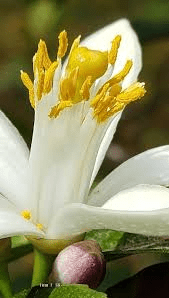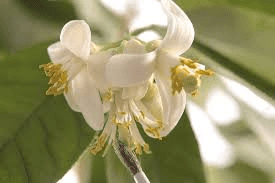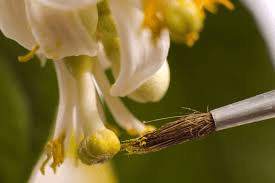The lemon pistil is the female reproductive organ of the lemon flower, essential for the formation of seeds and subsequent fruit development. Positioned centrally within the flower, it consists of three main parts: the stigma, style, and ovary.
1. Stigma: The stigma is the uppermost part of the pistil and is often sticky or feathery in texture. Its primary function is to receive pollen grains during pollination. The stigma’s surface is adapted to capture and hold pollen, providing a receptive site for the pollen tubes to grow and facilitate fertilization.
2. Style: The style is a slender tube-like structure that connects the stigma to the ovary. It serves as a conduit for the pollen tubes to transport sperm cells from the pollen grains to the ovules within the ovary. The style’s length and morphology can vary among plant species, influencing the efficiency of pollination and fertilization.
3. Ovary: The ovary is the swollen basal part of the pistil where ovules are housed. Within the ovary, numerous ovules contain female gametophytes (egg cells) that, when fertilized, develop into seeds. The ovary also undergoes significant growth and development following fertilization, eventually transforming into the mature fruit that encases the seeds.
In lemon flowers, the pistil is surrounded by the stamens (male reproductive organs), typically arranged in a ring. This arrangement promotes efficient pollination, as pollen released from the stamens can easily land on the sticky stigma of the pistil. Once pollen grains adhere to the stigma, they germinate and extend pollen tubes down the style towards the ovary, where fertilization occurs.
Successful fertilization results in the fusion of male and female gametes, forming a zygote that develops into an embryo within the seed. Surrounding tissues of the ovary then develop into the lemon fruit, which protects and nourishes the seeds during their maturation.
From a horticultural perspective, understanding the structure and function of the lemon pistil is crucial for promoting fruit production and ensuring genetic diversity within lemon cultivars. Factors such as pollination methods, environmental conditions, and pest management practices can influence the pistil’s reproductive efficiency and, consequently, fruit yield.
The lemon pistil plays a vital role in the reproduction of lemon plants by facilitating pollination, fertilization, and seed development. Its intricate structure and interactions with pollen are essential for the formation of healthy fruits and the continuation of the lemon species.
The Economic Importance and Uses of Lemon Pistils

1. Pollination: Lemon pistils receive pollen, enabling fertilization and leading to fruit production, ensuring high yields for farmers.
2. Genetic Research: Lemon pistils are studied in genetics to understand plant reproduction and develop improved lemon varieties.
3. Breeding Programs: Pistils are crucial in hybridization and breeding programs to produce new lemon varieties with desired traits.
4. Crop Yield Improvement: Proper fertilization involving pistils increases the quantity and quality of lemon fruit, benefiting agricultural output.
5. Medicinal Uses: Compounds in lemon pistils are studied for their potential health benefits, including anti-inflammatory and antioxidant properties.
6. Nutritional Supplements: Lemon pistil extracts can be processed into supplements for their nutritional and health benefits.
7. Aromatherapy: Essential oils derived from lemon flowers, including pistils, are used in aromatherapy for relaxation and well-being.
8. Culinary Uses: Lemon pistils can be used in culinary dishes, adding unique flavor and nutritional value.
9. Cosmetic Products: Extracts from lemon pistils are used in skincare products for their antioxidant and anti-inflammatory properties.
10. Fertilizer Production: Decomposed lemon pistils can be used as organic fertilizer, enriching the soil with nutrients.
11. Pest Control: Natural compounds in pistils can be used in eco-friendly pest control solutions.
12. Crafting: Dried lemon pistils can be used in arts and crafts projects, adding a natural element to decorations.
13. Perfume Industry: Aromatic compounds from lemon pistils are used to enhance the fragrance of perfumes.
14. Environmental Monitoring: Pollen analysis from pistils helps in studying environmental changes and plant health.
15. Educational Tools: Lemon pistils are used in educational settings to teach about plant biology and reproduction.
16. Natural Dyes: Lemon pistils can be used to create natural dyes for textiles and other materials.
17. Phytotherapy: Pistils are used in traditional herbal remedies for their potential therapeutic benefits.
18. Floral Arrangements: Lemon pistils add aesthetic and aromatic value to floral arrangements.
Read Also: 5 Health Benefits of Sarsaparilla (Smilax Ornata)
The Products and By-products That Can Be Derived From Lemon Pistils

1. Essential Oils: Lemon pistils are steam distilled to extract essential oils used in aromatherapy, perfumes, and cleaning products.
2. Nutritional Supplements: Extracts from lemon pistils are processed into dietary supplements for their nutritional benefits.
3. Herbal Teas: Lemon pistil extracts are used to make herbal teas with potential health benefits.
4. Natural Dye: Compounds from pistils can be used to create natural dyes for textiles and crafts.
5. Cosmetic Extracts: Extracts from lemon pistils are used in creams, lotions, and serums for their antioxidant and anti-inflammatory properties.
6. Fertilizers: Decomposed pistils are used as organic fertilizers, enriching the soil with essential nutrients.
7. Pest Control Products: Natural compounds in lemon pistils are used to create eco-friendly pest control solutions.
8. Perfumes: Aromatic compounds from pistils are used in the production of high-quality perfumes.
9. Culinary Garnishes: Lemon pistils can be used as garnishes or ingredients in various dishes for added flavor and nutrition.
10. Craft Materials: Dried pistils are used in crafting projects like making scented sachets and decorative items.
11. Health Drinks: Lemon pistil extracts are added to health drinks and smoothies for their nutritional value.
12. Phytotherapy Products: Pistils are used in traditional herbal remedies for their potential therapeutic benefits.
13. Beekeeping Products: Lemon flowers, including pistils, attract bees and contribute to honey production.
14. Environmental Studies: Pollen from pistils is used in environmental monitoring and research.
15. Educational Kits: Lemon pistils are included in educational kits for teaching about plant biology and reproduction.
16. Air Fresheners: Extracts from lemon pistils are used to create natural air fresheners.
17. Bath Products: Lemon pistil extracts are used in bath salts, bath bombs, and soaps for their soothing properties.
Read Also: 6 Health Benefits of Vitex (Vitex agnus-catus)
Frequently Asked Questions (FAQ’s) About Lemon Pistils

1. What are lemon pistils?
Lemon pistils are the female reproductive part of the lemon flower, consisting of the stigma, style, and ovary.
2. How do lemon pistils contribute to pollination?
Pistils receive pollen, enabling fertilization and leading to fruit development.
3. Can lemon pistils be used in cooking?
Yes, lemon pistils can be used as garnishes or ingredients in culinary dishes for unique flavor and nutritional value.
4. Are there health benefits to lemon pistils?
Lemon pistils have antioxidant and anti-inflammatory properties, making them potentially beneficial for health when used in supplements.
5. How are lemon pistils used in skincare?
Extracts from lemon pistils are used in skincare products for their antioxidant and anti-inflammatory benefits, helping to protect and rejuvenate the skin.
6. Can lemon pistils be used to make tea?
Yes, lemon pistil extracts can be used to make herbal teas with potential health benefits.
7. What role do lemon pistils play in beekeeping?
Lemon flowers, including pistils, attract bees, which are essential for pollination and honey production.
8. Are lemon pistils used in perfumes?
Yes, aromatic compounds from lemon pistils are used to enhance the fragrance of perfumes.
9. How are lemon pistils processed into essential oils?
Lemon pistils are steam distilled to extract essential oils, which are then used in various aromatherapy and cosmetic products.
10. Are there any traditional medicinal uses for lemon pistils?
Yes, lemon pistils are used in traditional herbal remedies for their potential therapeutic benefits, such as reducing inflammation and promoting overall health.
Read Also: Complete Steps in Aluminum Recycling Guide





